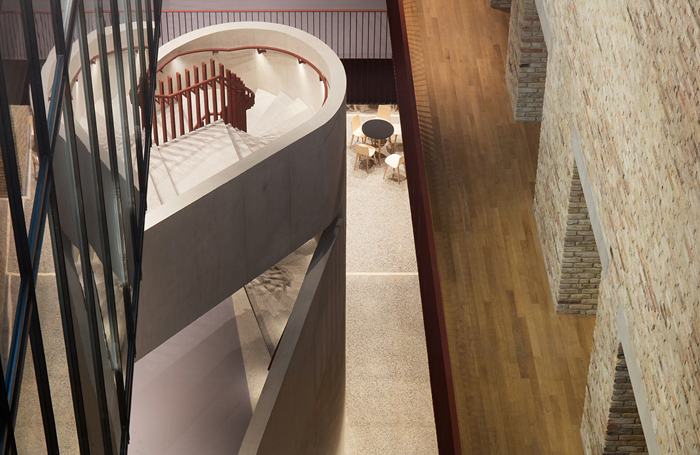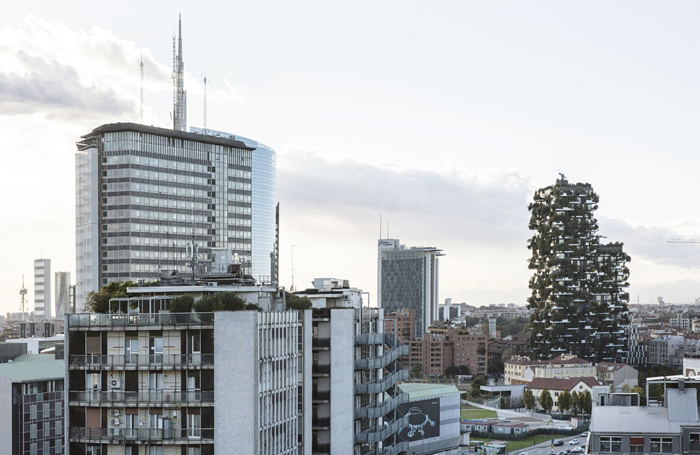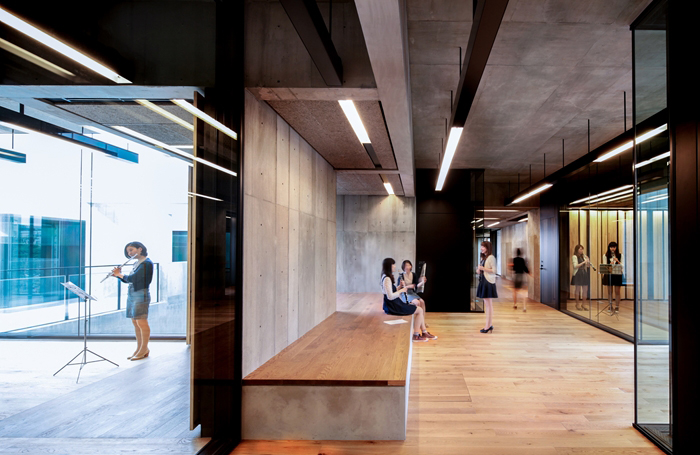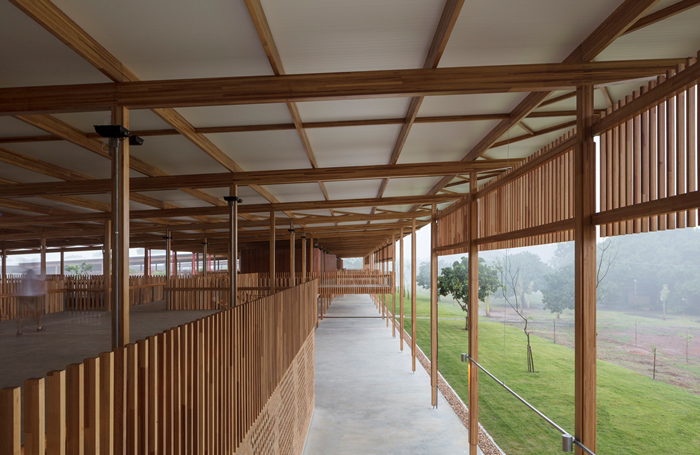As we count down the final days until the 2018 RIBA International Prize winner is announced, RIBA Head of Awards Matt Dobson shares his dispatches from the jury visits that took place around the world earlier this year. Which of the four shortlisted projects will scoop the prize? Find out on Wednesday 21 November.
DAY ONE: Budapest, Hungary
The first full day of the ‘Grand Tour’ and it's a fascinating one.
Meet Nora and Miklos, our local jurors in Budapest, for lunch. Nora is American by birth but through what she describes as a series of “mishaps and coincidences” has ended up in Hungary, which is of course at this moment the eye of a global political storm. In Budapest, at least, that storm is symbolised in particular by one building, and it’s the one we’re here to see: O’Donnell & Tuomey’s Central European University.
Nora and Miklos patiently set the scene for us. This is a tense time in Budapest; the university is feeling political, funding, and regulatory pressures that could undermine its survival, and the building itself has emerged as a symbol of rift for the metropolitan intelligentsia. Michael Ignatieff, Vice Chancellor, former BBC Culture Show host, and one time Canadian political candidate joins us in the afternoon. They love their campus here and he stresses how much they don’t want to leave, as this is a truly special building.
He’s right. The spaces work extremely well, with a light-filled library eschewing recent trends and going for quiet, peaceful and pleasant spaces filled with books, light, and good views. You sense that in the current Hungarian climate, the students are quite content with this. A superb roof garden gives stunning views across the Danube, back towards the Parliament building which looks back, ever so slightly menacingly.

DAY THREE – Milan, Italy
And so to Milan, where next on our list is Boeri Studio's Bosco Verticale ("Vertical Forest").
We are met outside a small Trattoria by a cast of thousands. The architect, Stefano Boeri, skilfully delegates questions to others and fields a never-ending series of calls. Two burly gardeners abseil down from high up the building, landing at pavement level with great panache at the exact moment we get outside to take in the front elevation. This visit is concluded at a nearby restaurant where strong coffee and delicious almond and chocolate paticceria miraculously appear along with copies of the three volume book about the project. This is a RIBA visit done in a uniquely Italian way, and it’s brilliant.
This part of Milan is prosperous and serious. It's an area for trading in global markets and the predictable architecture of the glazed tower has staked its claim. But Stefano and his army have other ideas. Not in defiance of the context - why waste effort on that? They just have other ideas. Vertical bio-diversity is the name of the game. A place for greenery, bugs, and people to co-habit. Bold cantilevers are loaded with growing trees, but they just seem to work.
The greenery is well loved. Verdant balconies are a defining feature in residential Milan, but this project takes them to a new level and has become a symbol of the city, all over the tourist leaflets in our hotel. It all contributes to a pair of buildings that are wonderfully local and amusing - and of course endlessly changing.
We are shown around the apartment of the Inter Milan coach (a nice jury visit touch there!) and the effect of waking up and brushing your teeth whilst peering out through a forest with the city of Milan as a backdrop is quite a beguiling one, and was not lost on our local juror Marco, who actually likened it to the Eiffel Tower in terms of its importance as a work of architecture on mainland Europe. High praise indeed. Either way, the travelling jury has yet to see a bad building.

DAY FIVE – Tokyo, Japan
Joined today by new fellow travellers Joshua Bolchover and Gloria Cabral. If anyone was ever made for this jury it’s Gloria. Sleep doesn’t count for much and, judging by the stamps on her supplementary passport, air travel is not much of an obstacle. She arrives at 12pm local time. I tell her the car will be ready at 1pm. She is there, ready and waiting to go.
We are here to see Nikken Sekkei’s Toho Gakuen Music School, in a suburb of Tokyo. Nikken Sekkei are truly astonishing in scale. They operate across China, Japan and South East Asia. The man we are here to meet is Senior Director Tomohiko Yamanishi. He tells us that within his division 800 architects report to him. He is a busy man; thousands of schemes go out with his name on. Nevertheless, he has taken on this project that is perhaps atypical for Nikken Sekkei; a private music school for undergraduates.
Tomohiko likens music schools to prisons in plan: long corridors, small cells, no opportunity for transfer of ideas or (crucially) sounds. Rejecting this model is the cornerstone of his scheme. A clever but incredibly simple timber acoustic system allows resonance to be moderated and, when certain apertures are open, allows the music to flow into the communal spaces that link them.
The effect is quite lovely. Snatches of opera combine with piano and violin music in different rooms, the musicians unaware of each other’s presence when they want to be, while passers-by can still enjoy the ensemble. If the musicians wish (and as Tomohiko would prefer) there are visual interactions too. It’s a clever effect reinforced by impromptu stage areas littered around the spaces. Externally the school is extremely well worked. It would hold its own anywhere and announces itself in a modest and dignified way.
Making the final four of the RIBA International Prize is a huge compliment, Tomohiko tells us. It shows the value in designing by hand and only resorting to the computer to solve the most difficult of problems. His personal triumph is immense, and it’s hard not to salute the craft and thought that has gone into creating an environment in which to learn and to share.

DAY SEVEN – Travelling
I am on Japanese time, but could be on European time. Gloria is on South American, which could be to her advantage. Whatever time it is in the real world, one thing is clear. We are all tired.
At Sao Paulo we meet our local jury rep, Jose Paulo Neves Gouvea. He is an enormous source of knowledge on everything related to Brazilian architecture. A proud and hospitable host who knows Gloria by reputation only. She is something of a celebrity in these parts and it is clear he is delighted to meet her.
Jose Paulo is a huge Paulo Mendes da Rocha fan. He explains how big the Royal Gold Medal announcement was here in 2016 and 2017. After a few beers we set off to find da Rocha's one building in Goiana, the Jockey Club, a kind of hotel-cum-leisure retreat within the city. It’s long since closed now and its faded grandeur is sad to see. I realise it's the first da Rocha building I have ever encountered at close quarters. Through the security fencing, you do get a sense of the ambition of the place, but it looks as though it’s not much longer for this world. This is a poor district of the city and plans are afoot for redevelopment. The people of Goiana don't need Jockey Clubs any more.
DAY EIGHT – Tocantins, Brazil
RIBA International Prize visits are peculiar things. People have been extremely generous and hospitable on this trip. The trip to Aleph Zero’s ‘Children Village’ is a case in point. The reverse scenario here would be a group of Brazilian architects turning up in the Midlands say, and then some English architects being expected to drive them to the Lake District, feed them, water them, show them around their building, give them accommodation, and speak Portuguese for the duration of the visit.
Having travelled 13,000 miles, we are met early in our Palmas Hotel by Aleph Zero (Gustavo Utrabo and Pedro Duschenes). A drive takes us out of Palmas and north towards the edge of the forest, passing and crossing on the way the Tocantins River, which was dammed in 1980s to create a more fertile basin. For long sections the road acts as the border between untamed forest and the vast cultivated soy fields.
We pull up the drive of the Children Village and are met by the school principal. An amiable chap who lives on site, he explains the background over lunch, before our now large party heads over to see Aleph Zero’s handiwork.
Two buildings – one for girls, one for boys – are at opposite ends of the site. Both are the same in plan and adorned similarly. It is only by reference to the landscape that you can tell them apart. These are schools for children from low income Tocantins families. The entire project is funded by the Banco Bradesco Foundation, apparently the second largest charitable fund after the Bill Gates Foundation.
That is not to say that budget was no object here. It was, and Aleph Zero have made it go a long way. Arranged around three spacious courtyards, each building contains dormitories at ground level, and a series of support service rooms for day-to-day living: laundry, office space for staff, store rooms and so on. The courtyards are well shaded, allowing natural breeze to pass through and combining with attractive and pleasant water features. There is no heating or cooling at all, despite temperatures reaching the mid-40s in summer. Apparently, the shading and natural ventilation are enough to maintain a comfortable living environment.
On the upper level, the buildings come into their own. Slatted cabins of treated cedar make superb enclosed TV rooms, with large stepped seating. Table tennis and chess tables are built in. The kids are adapting these buildings to fit their needs, and this is part of the joy for Aleph Zero. They have been prescriptive but without being overbearing. There is plenty of scope to adapt their space and to re-shape it, if that’s what the kids want to do. They have also been supportive without being patronising, encouraging growth without cosseting it.
This is a sophisticated and clever response to a difficult challenge, and the maturity of the complex impresses the jury, particularly as Aleph Zero are such a young practice.

DAY TEN - Travelling
The final day means it’s statistics time. We have covered 28,750 miles (slightly more than the circumference of the Globe), across 10 flights, spending 65 hours in the air, and 25 hours in airports.
It's without doubt the strangest route anyone has ever taken from Luton to Manchester, but it is the most memorable one. The Grand Jury (Kazuyo Sejima, Gloria Cabral, Peter Clegg, Elizabeth Diller, and Joshua Bolchover) will reconvene in a few weeks’ time to make the tough decision, and for me it's been an absolute privilege to do the trip and I know I am very lucky indeed.









